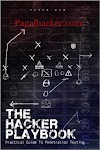Directory Traversal | Path Traversal Vulnerability
In this artice, we'll explain what directory traversal is, describe how to carry out path traversal attacks and circumvent common obstacles, and spell out how to prevent path traversal vulnerabilities.
What is directory traversal?
Directory traversal (also known as file path traversal) is a web security vulnerability that allows an attacker to read arbitrary files on the server that is running an application. This might include application code and data, credentials for back-end systems, and sensitive operating system files. In some cases, an attacker might be able to write to arbitrary files on the server, allowing them to modify application data or behavior, and ultimately take full control of the server.
Reading arbitrary files via directory traversal
Consider a shopping application that displays images of items for sale. Images are loaded via some HTML like the following:
<img src="/loadImage?filename=218.png">
The loadImage URL takes a filename parameter and returns the contents of the specified file. The image files themselves are stored on disk in the location /var/www/images/.
To return an image, the application appends the requested filename to
this base directory and uses a filesystem API to read the contents of
the file. In the above case, the application reads from the following
file path:
/var/www/images/218.png
The application implements no defenses against directory traversal attacks, so an attacker can request the following URL to retrieve an arbitrary file from the server's filesystem:
https://insecure-website.com/loadImage?filename=../../../etc/passwd
This causes the application to read from the following file path:
/var/www/images/../../../etc/passwd
The sequence ../ is valid within a file path, and means to step up one level in the directory structure. The three consecutive ../ sequences step up from /var/www/images/ to the filesystem root, and so the file that is actually read is:
/etc/passwd
On Unix-based operating systems, this is a standard file containing details of the users that are registered on the server.
On Windows, both ../ and ..\ are valid directory traversal sequences, and an equivalent attack to retrieve a standard operating system file would be:
https://insecure-website.com/loadImage?filename=..\..\..\windows\win.ini
bypass filters for file path traversal vulnerabilities
Many applications that place user input into file paths implement some kind of defense against path traversal attacks, and these can often be circumvented.
If an application strips or blocks directory traversal sequences from the user-supplied filename, then it might be possible to bypass the defense using a variety of techniques.
You might be able to use an absolute path from the filesystem root, such as filename=/etc/passwd, to directly reference a file without using any traversal sequences.
You might be able to use nested traversal sequences, such as ....// or ....\/, which will revert to simple traversal sequences when the inner sequence is stripped.
You might be able to use various non-standard encodings, such as ..%c0%af or ..%252f, to bypass the input filter.
If an application requires that the user-supplied filename must start with the expected base folder, such as /var/www/images, then it might be possible to include the required base folder followed by suitable traversal sequences. For example:
filename=/var/www/images/../../../etc/passwd
If an application requires that the user-supplied filename must end with an expected file extension, such as .png,
then it might be possible to use a null byte to effectively terminate
the file path before the required extension. For example:
filename=../../../etc/passwd%00.png
How to prevent a directory traversal attack
The most effective way to prevent file path traversal vulnerabilities is to avoid passing user-supplied input to filesystem APIs altogether. Many application functions that do this can be rewritten to deliver the same behavior in a safer way.
If it is considered unavoidable to pass user-supplied input to filesystem APIs, then two layers of defense should be used together to prevent attacks:
- The application should validate the user input before processing it. Ideally, the validation should compare against a whitelist of permitted values. If that isn't possible for the required functionality, then the validation should verify that the input contains only permitted content, such as purely alphanumeric characters.
- After validating the supplied input, the application should append the input to the base directory and use a platform filesystem API to canonicalize the path. It should verify that the canonicalized path starts with the expected base directory.
File file = new File(BASE_DIRECTORY, userInput);
if (file.getCanonicalPath().startsWith(BASE_DIRECTORY)) {
// process file
}







0 Comments
Please do not enter any spam link in the comment box.